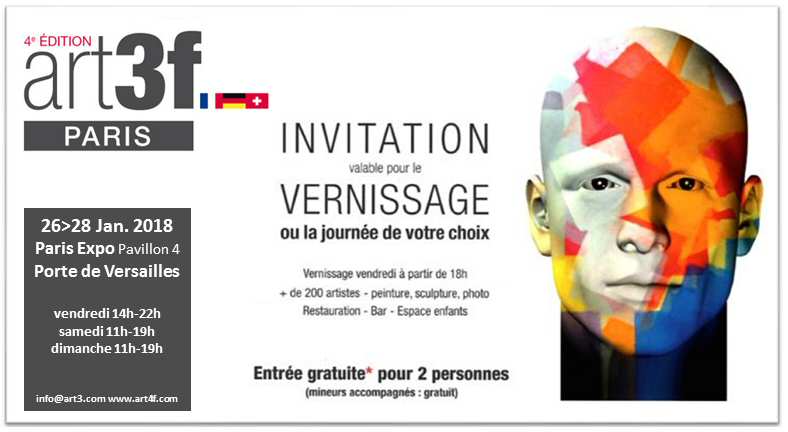My single line text
My single line text
My single line text

DER SUCHENDE
ART3F Paris International Contemporary Art Fair
January 26th - 28th 2018

Andrea Fallini
After the exhibition held in Mulhouse (France), which was a sort of discussion on the incoherencies of attitudes and common positions concerning the violence on the women (and the violence generally), on the slogans that daily bomb us, on the spaces of liberty that each of us sees to reduce in a society of the appearance and not of the being, B.Zanconato proposes in Paris a new show, a new chapter of her narrative season titled "DER SUCHENDE", that brings us to reflect on themes completely different even if complementary to the precedents. The scenery of reference is always the contemporary society with its contradictions and its paradigms. The artist remembers that we are crossing a phase of great changes at different levels but that they intersect and they influence the life of each of us. One of these is due by the great impulse given to the information interchange by the great global network, by internet and the media making available the main events that happen also in the most remote places. And at the same time they offer to the disinherited ones of the world some hopes of ransom unthinkable in their zones of origin and that are at the base of the migratory flows of the last years.
“WELTSCHMERZ”, the first artwork of the new narration proposed by B.Zanconato, faces these subjects. The artist tells that the work was born following one of the so many tragic shipwrecks of barges, full of fugitives, in the Mediterranean Sea and from the consequent feeling of empathy and sorrow she has felt in front of the desperation and the death of so many people. Her words define the thin metallic figures placed to the center of the artwork, that seem to launch desperate howls among the threatening waves of a gloomy sea. To notice that the scene is inserted inside a container, that is not a frame, but rather a screen over which the cries of help seem to project. On a different plan, to a side, almost out of it, another human figure, outlined by iron wire, seems to want to take the distance, to move away from that wretched scenery. On the bottom, a small cascade of red threads near to the artwork title that B.Zanconato stamped on a metallic plate. “Weltschmerz” is a German word with a nuanced meaning; depending on the context it gives account of that feeling of mistrust or sadness in front of the cruelty and the evil of the world, of that kind of suffering, characteristic of the most sensitive people, tied up to the empathy that can be felt in front of the pain of others. And empathy is the key theme of this artwork.
“WELTSCHMERZ”, the first artwork of the new narration proposed by B.Zanconato, faces these subjects. The artist tells that the work was born following one of the so many tragic shipwrecks of barges, full of fugitives, in the Mediterranean Sea and from the consequent feeling of empathy and sorrow she has felt in front of the desperation and the death of so many people. Her words define the thin metallic figures placed to the center of the artwork, that seem to launch desperate howls among the threatening waves of a gloomy sea. To notice that the scene is inserted inside a container, that is not a frame, but rather a screen over which the cries of help seem to project. On a different plan, to a side, almost out of it, another human figure, outlined by iron wire, seems to want to take the distance, to move away from that wretched scenery. On the bottom, a small cascade of red threads near to the artwork title that B.Zanconato stamped on a metallic plate. “Weltschmerz” is a German word with a nuanced meaning; depending on the context it gives account of that feeling of mistrust or sadness in front of the cruelty and the evil of the world, of that kind of suffering, characteristic of the most sensitive people, tied up to the empathy that can be felt in front of the pain of others. And empathy is the key theme of this artwork.
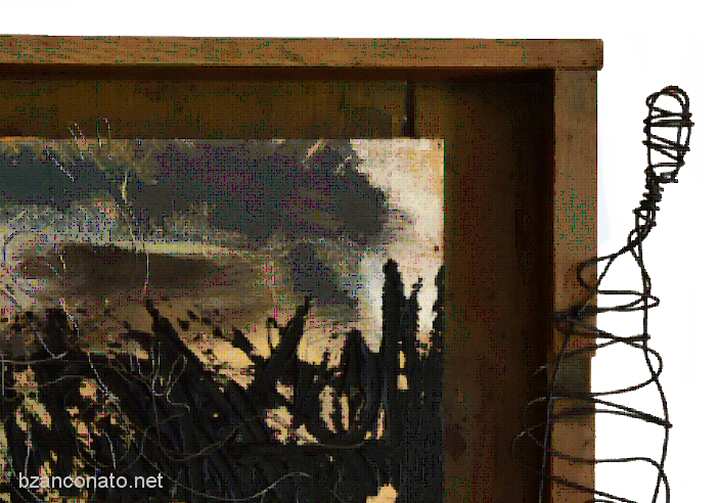
Empathy represents for B.Zanconato the symbol of the human sensibility that is compared with another symbol on which the dialectics of the interpretation plays: that of the container/screen (that could be the television or the computer screen) that turns the human tragedies into images of diversion. The screen, in fact, is an ambiguous surface, on which facts, information and news of all the types are projected but also programs of diversion in which the distance from the reality is on purpose amplified. On the screen all is mixed and it appears far. And everything becomes virtual reality, fiction and show: also the tragedies brought by the news-bulletins. All becomes indistinct: reality or pretense? true or artificial?
An indistinct chaos in which are compared and confused the pain of so much humanity and the scarce empathic attention of whom sees the screen looking for relaxation and lightness (often after one of the so many difficult working days).
An indistinct chaos in which are compared and confused the pain of so much humanity and the scarce empathic attention of whom sees the screen looking for relaxation and lightness (often after one of the so many difficult working days).
Yes, because, if on one side the migrant ones are escaping from tragic situations, on the other hand also the ordinary European citizen is facing never seen problems and difficulties. Beside, these are difficult times or, better, of rapid change. Everything is changing because the consolidated models are not able to answer to the new demands anymore. The world of communications in real time, easy navigation, quick comparisons, that each of us can lead by taking advantage of the technological means, are making obsolete also the concepts of nation and border.
The world of work is constantly changing due to the globalization of the economic exchanges, within which companies move manufacturing plant and staff based on simple and inexorable logic of profit. Large multinationals, well organised to take advantage of national and supranational legislation, have overturned the paradigms of law and work stability, putting on the balance pan of bargaining with central Governments the question, if not the threat, of the possible closure of large plants (to reopen in countries where labour costs and taxation are more favorable). Consequently, social models, generally based on a certain uniformity of vision and condition, including economic, of the components, are no longer able to take into account the increasing variability of the reference scenario and of the conditions of population, as well as its growing ethnicity (which otherwise, is nothing but cosmopolitanism). And the economic and financial crisis of the past few years has accelerated those processes initiated in the '80 and '90 years.
The world of work is constantly changing due to the globalization of the economic exchanges, within which companies move manufacturing plant and staff based on simple and inexorable logic of profit. Large multinationals, well organised to take advantage of national and supranational legislation, have overturned the paradigms of law and work stability, putting on the balance pan of bargaining with central Governments the question, if not the threat, of the possible closure of large plants (to reopen in countries where labour costs and taxation are more favorable). Consequently, social models, generally based on a certain uniformity of vision and condition, including economic, of the components, are no longer able to take into account the increasing variability of the reference scenario and of the conditions of population, as well as its growing ethnicity (which otherwise, is nothing but cosmopolitanism). And the economic and financial crisis of the past few years has accelerated those processes initiated in the '80 and '90 years.
To a different level, even the traditional concept of the family is severely put to the test.
Life rhythms that do not leave much room for the time shared in household add up at sunset of the traditional distribution of roles, given that technological development has made the most of the activities within the reach of all the muscles.
Moreover, all the members of the household have to contribute to maintain the high living standard (and consumption), characteristic of contemporary existence.
In times of deep economic crisis, like the ones we are still facing, this causes some trouble to keep the positions gained in the past and the fear of not being able to maintain the same lifestyle and losing what it was achieved.
And this fear creates ghosts ...
Life rhythms that do not leave much room for the time shared in household add up at sunset of the traditional distribution of roles, given that technological development has made the most of the activities within the reach of all the muscles.
Moreover, all the members of the household have to contribute to maintain the high living standard (and consumption), characteristic of contemporary existence.
In times of deep economic crisis, like the ones we are still facing, this causes some trouble to keep the positions gained in the past and the fear of not being able to maintain the same lifestyle and losing what it was achieved.
And this fear creates ghosts ...
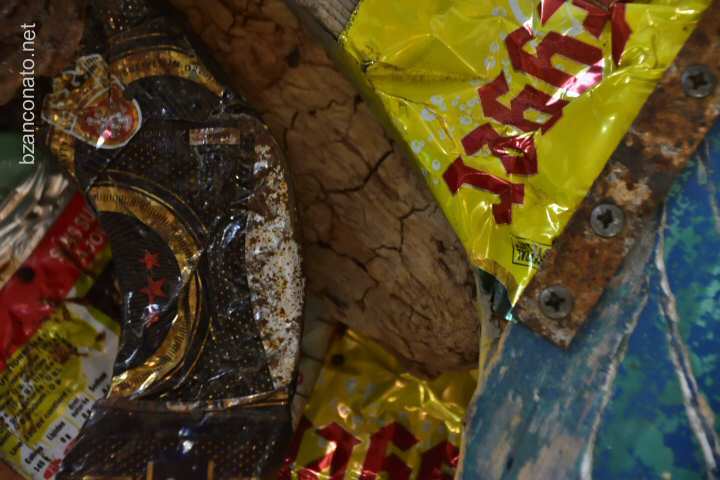
A situation which may appear chaotic, without reference points and that, in fact, so appears to many. Also because mentalities and ways of doing things, rules and laws established in different and far times (and worlds), coexist and end up slowing, if not to hinder, the (inexorable) change which is in place. During the season of the removal of borders, here we see the return of nationalist (or regionalist, Brexit, Catalonia, ...) or, even worse, nazi-fascist tendencies. In the era of global transport and traffic, here is that air traffic from certain countries is prevented.
Exactly a “CHAOS”, like the artwork (with the same name) that the artist chose to have on the central wall of the exhibition and that perfectly symbolizes this situation of coexistence among exhausted items and others in which we see the contemporary world; among the parts where it is clear the effect of time and those in which the patina is still undoubtedly up to date. On the background is the consumerism, with rapid turnover of consumer goods, that produces waste (including human waste), rubbish to dispose, discarded materials, which then are those that the artist has made masterful use for her artwork.
It is undoubtedly a difficult cohabitation to match. In fact, in some areas, the elements have borders that don't match perfectly but that's part of the things: old and new don't match ever perfectly ... the "CHAOS" is that too.
“CHAOS” is the resumption of the Greek word used by the artist as the representation of contemporary life, the loss of points of reference: it is as to get around in the dark, blindly.
But what is life? Is it not move blindly without really knowing which course we're taking? is it not even injustice, pain, hurt, difficulty and uncertainty ... without a reason?
This question introduces a third artwork on display: “HIER IST KEIN WARUM”. The German phrase, which literally means “there is no why here”, is a quote from the book “If this is a man” by Primo Levi in which he told his tragic experience of Jew deported to Auschwitz. In particular, upon arrival in the camp, upset about the treatment of prisoners, P. Levi question insistently at all people why (warum) until one of his companions said: “Hier ist kein warum” (there is no why here).
B.Zanconato tells that the artwork was born from a true story concerning the Auschwitz camp: in early 2016, a ring and a necklace that belonged to one of the victims of the camp were found hidden in a false bottom of an enameled cup. “I thought that love was speaking again through that ring, even from a place where dignity and love had become meaningless concepts for millions of people. A sign of hope.
Exactly a “CHAOS”, like the artwork (with the same name) that the artist chose to have on the central wall of the exhibition and that perfectly symbolizes this situation of coexistence among exhausted items and others in which we see the contemporary world; among the parts where it is clear the effect of time and those in which the patina is still undoubtedly up to date. On the background is the consumerism, with rapid turnover of consumer goods, that produces waste (including human waste), rubbish to dispose, discarded materials, which then are those that the artist has made masterful use for her artwork.
It is undoubtedly a difficult cohabitation to match. In fact, in some areas, the elements have borders that don't match perfectly but that's part of the things: old and new don't match ever perfectly ... the "CHAOS" is that too.
“CHAOS” is the resumption of the Greek word used by the artist as the representation of contemporary life, the loss of points of reference: it is as to get around in the dark, blindly.
But what is life? Is it not move blindly without really knowing which course we're taking? is it not even injustice, pain, hurt, difficulty and uncertainty ... without a reason?
This question introduces a third artwork on display: “HIER IST KEIN WARUM”. The German phrase, which literally means “there is no why here”, is a quote from the book “If this is a man” by Primo Levi in which he told his tragic experience of Jew deported to Auschwitz. In particular, upon arrival in the camp, upset about the treatment of prisoners, P. Levi question insistently at all people why (warum) until one of his companions said: “Hier ist kein warum” (there is no why here).
B.Zanconato tells that the artwork was born from a true story concerning the Auschwitz camp: in early 2016, a ring and a necklace that belonged to one of the victims of the camp were found hidden in a false bottom of an enameled cup. “I thought that love was speaking again through that ring, even from a place where dignity and love had become meaningless concepts for millions of people. A sign of hope.
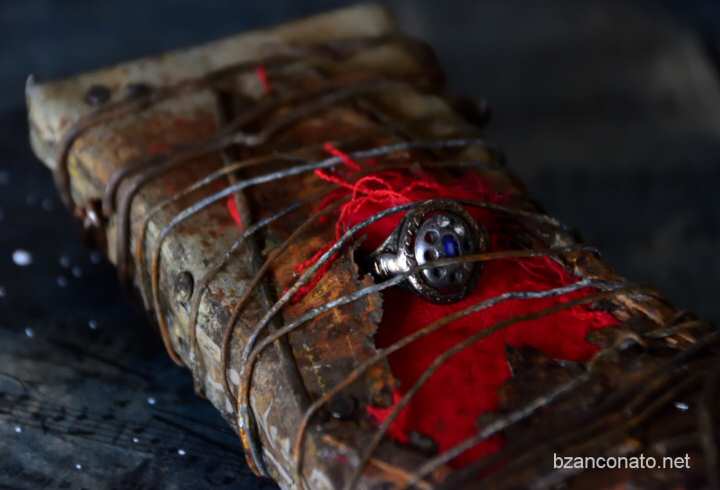
I thought about how often that person – for me a woman – she had strength hands clutching that cup, whose treasure concealed meant “I will survive””.
And with this artwork B.Zanconato reveals, with her symbolic language, another paradigm of her vision: it is love, feeling, human perspective which gives a meaning to existence, which gives us that energy able of making us capable to face the toughest challenges (and what could be harder than Auschwitz camp?). And all this through the example of the anonymous hero of Auschwitz, who has preserved the image of her humanity in the form of jewelry that kept her close to her dear, reckless of danger. Of course, this didn’t save her life but certainly prevented her annihilation as a human being, i.e. prevented her feelings and, consequently, her human essence were canceled.
And that's what B.Zanconato wants to reiterate again today: times have changed, there are no longer extermination camps (at least not in our Western societies). However, much like in the nazi concentration camps, we are nothing but numbers surrounded by a mechanism in which only economic budgets, statistical data, trends act as reference... and where people, their feelings, their diversity, their sufferings are not factors that come into play. In this state of affairs, the bloated European bureaucracies (maybe not far relatives of nazi bureaucratic machine, which through the fragmentation of tasks and technicalities has been able to make forget its employees the horrors lurked behind their daily operations) certainly don't put the individual and his needs in the spotlight ... especially in these times, complex to interpret. On the other hand, it is always easier, more convenient switch off the brain and conscience and follow and apply procedures rained down from above ...
However, it is difficult to get out of this impasse. In fact, you should not go against the rules on which rests the bureaucratic society that has refined more and more instruments of repression. By contrast the sense of this obsessive presence, if non-interference, of the bureaucracy, with its power of life and death on many companies and initiatives, on the lives of people, often blocked in their efforts to undertake, is incomprehensible. “HIER IST KEIN WARUM”.
Immersed in this world where (not only ideological) legacies of the past continue to govern the present, and where the new scenario, which is very different from that of the previous generation, requires great thoughts and political, economic and social changes, we have to take note of this moment of standoff. It might seem a generational conflict and maybe so, but especially young people (in Italy, but perhaps it is no different in other parts of Europe) are in the awkward position of having to pay the price of evil choices and decisions taken by the previous generations.
And with this artwork B.Zanconato reveals, with her symbolic language, another paradigm of her vision: it is love, feeling, human perspective which gives a meaning to existence, which gives us that energy able of making us capable to face the toughest challenges (and what could be harder than Auschwitz camp?). And all this through the example of the anonymous hero of Auschwitz, who has preserved the image of her humanity in the form of jewelry that kept her close to her dear, reckless of danger. Of course, this didn’t save her life but certainly prevented her annihilation as a human being, i.e. prevented her feelings and, consequently, her human essence were canceled.
And that's what B.Zanconato wants to reiterate again today: times have changed, there are no longer extermination camps (at least not in our Western societies). However, much like in the nazi concentration camps, we are nothing but numbers surrounded by a mechanism in which only economic budgets, statistical data, trends act as reference... and where people, their feelings, their diversity, their sufferings are not factors that come into play. In this state of affairs, the bloated European bureaucracies (maybe not far relatives of nazi bureaucratic machine, which through the fragmentation of tasks and technicalities has been able to make forget its employees the horrors lurked behind their daily operations) certainly don't put the individual and his needs in the spotlight ... especially in these times, complex to interpret. On the other hand, it is always easier, more convenient switch off the brain and conscience and follow and apply procedures rained down from above ...
However, it is difficult to get out of this impasse. In fact, you should not go against the rules on which rests the bureaucratic society that has refined more and more instruments of repression. By contrast the sense of this obsessive presence, if non-interference, of the bureaucracy, with its power of life and death on many companies and initiatives, on the lives of people, often blocked in their efforts to undertake, is incomprehensible. “HIER IST KEIN WARUM”.
Immersed in this world where (not only ideological) legacies of the past continue to govern the present, and where the new scenario, which is very different from that of the previous generation, requires great thoughts and political, economic and social changes, we have to take note of this moment of standoff. It might seem a generational conflict and maybe so, but especially young people (in Italy, but perhaps it is no different in other parts of Europe) are in the awkward position of having to pay the price of evil choices and decisions taken by the previous generations.
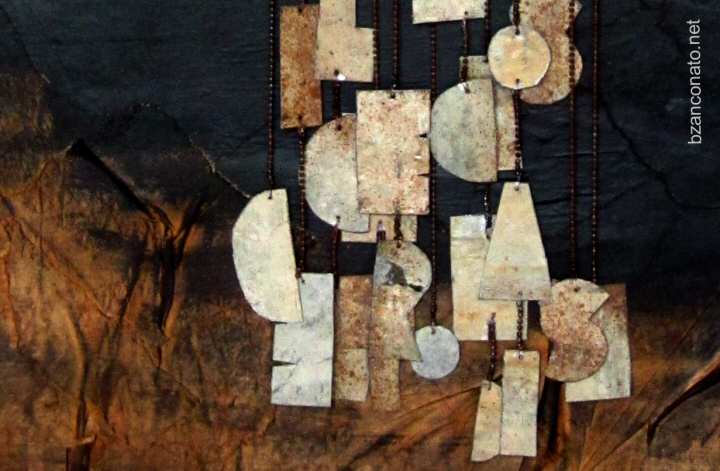
"Hier ist Kein warum", or maybe yes, but we can't do much until the time (only?) will be ripe.
Because the difficult to change things, combined with evidence that maintaining the current status can only worsen the situation, many feel dejection and disappointment. But this is also an opportunity to make a profound reflection. This is the indication that B.Zanconato provides us with “DARKNESS”.
The artist herself mentions about one of her poems that encapsulates the feeling expressed in the artwork:
Because the difficult to change things, combined with evidence that maintaining the current status can only worsen the situation, many feel dejection and disappointment. But this is also an opportunity to make a profound reflection. This is the indication that B.Zanconato provides us with “DARKNESS”.
The artist herself mentions about one of her poems that encapsulates the feeling expressed in the artwork:
“... wrapped in a damp and cold dark
Only the noise of metal rain
that incessant, is falling in my heart.
Everyone has to tidy up the chaos inside itself.”
Only the noise of metal rain
that incessant, is falling in my heart.
Everyone has to tidy up the chaos inside itself.”
“Everyone has to tidy up the chaos inside itself” and this terse sentence, concealed in the artwork itself, is the point of the question. This reorganization, restructuring operation becomes necessary in the most difficult moments, in which we feel the need to get rid of unnecessary weight. It’s about to focus on the most important matter and to revise the scale of values: it’s about to recognize the person who we really are. It's true: this requires strength, a strength that we think we have probably not but that, deep down, we. As the person, who hid the jewels in the false bottom of his coffee cup to Auschwitz, has been able to find. Or the strength which Nelson Mandela, in his hard and long years of imprisonment in South African prisons for his opposition to apartheid, has been able to found by reading the poem “Invictus” by W. E. Henley, whose first verse provided the cue for another artwork in the show: “OUT OF THE NIGHT”.
And it is precisely this encouragement that B. Zanconato intends to launch with “OUT OF THE NIGHT”: there is no trial, there's no situation which can annihilate this strength, which can turn off our soul.
And it is precisely this encouragement that B. Zanconato intends to launch with “OUT OF THE NIGHT”: there is no trial, there's no situation which can annihilate this strength, which can turn off our soul.
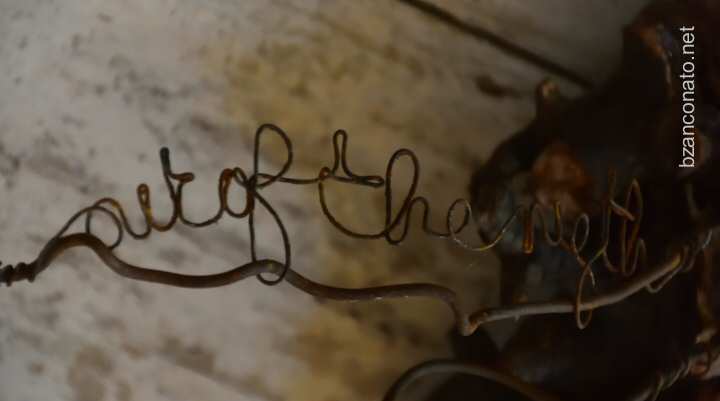
The most difficult situations, more stringent tests, the deepest wounds have the ability to leave marks on us but also to awaken our deepest resources. Resources often lie dormant in a lethargy dictated from the tedium of contemporary life, in many cases experienced by reflex, in pursuit of collective desires (and therefore not ours) and that then do not really satisfy when achieved. Indeed, in some ways, the difficulties, the hard times, are an opportunity to rediscover these hidden resources, and, ultimately, to find that, as stated in the poem by W.E. Henley, “It matters not how strait the gate, How charged with punishments the scroll, I am the master of my fate: I am the captain of my soul.”
And “DIVENIRE” (in Italian "to become"), a subsequent artwork that the artist has placed in her exhibition, is the representation of that moment when you have the perception of this unknown force. Is a ray of light in the blackest night, a perspective that opens as a result of a glimpse into the dark, a new skin that appears below the one you are getting chapped. It is the turning point after which begins the process of changing (exactly "DIVENIRE", to become) that shows our true personality, that is our indomitable soul (is evident here the connection with some of the issues addressed by the artist in previous exhibition “TESHUVA”: the confrontational relationship between the individual and society, introspection, solitude, the myth of Er…). This is a true deliverance: as a person who had been locked up for a long time and that now longs to see the light again, indeed, to come to light.
And this introduces a next work on display: “RUACH”. Rùach is a Hebrew term which literally means breath/blow or wind but which often is used to refer to the spirit. To accompany the artwork a poem of the artist that describes this sense of release:
And “DIVENIRE” (in Italian "to become"), a subsequent artwork that the artist has placed in her exhibition, is the representation of that moment when you have the perception of this unknown force. Is a ray of light in the blackest night, a perspective that opens as a result of a glimpse into the dark, a new skin that appears below the one you are getting chapped. It is the turning point after which begins the process of changing (exactly "DIVENIRE", to become) that shows our true personality, that is our indomitable soul (is evident here the connection with some of the issues addressed by the artist in previous exhibition “TESHUVA”: the confrontational relationship between the individual and society, introspection, solitude, the myth of Er…). This is a true deliverance: as a person who had been locked up for a long time and that now longs to see the light again, indeed, to come to light.
And this introduces a next work on display: “RUACH”. Rùach is a Hebrew term which literally means breath/blow or wind but which often is used to refer to the spirit. To accompany the artwork a poem of the artist that describes this sense of release:
... under layers and layers of sediment…
…I dug and dug …
... behind thick blankets,
curtains of a decoration not mine,
I searched and searched
...... deep down,
tied by a thousand chains,
her arms clasped by a thousand laces,
ankles thousand strains,
the mouth a thousand gags…
... weak but still alive,
I tried to untie her,
to untie the laces,
to open the logs,
to remove the gags…
.... she started breathing better,
she moved slowly the limbs …
... from the mouth,
a liberating and challenge cry ...
I recognize her:
it's me.
…I dug and dug …
... behind thick blankets,
curtains of a decoration not mine,
I searched and searched
...... deep down,
tied by a thousand chains,
her arms clasped by a thousand laces,
ankles thousand strains,
the mouth a thousand gags…
... weak but still alive,
I tried to untie her,
to untie the laces,
to open the logs,
to remove the gags…
.... she started breathing better,
she moved slowly the limbs …
... from the mouth,
a liberating and challenge cry ...
I recognize her:
it's me.
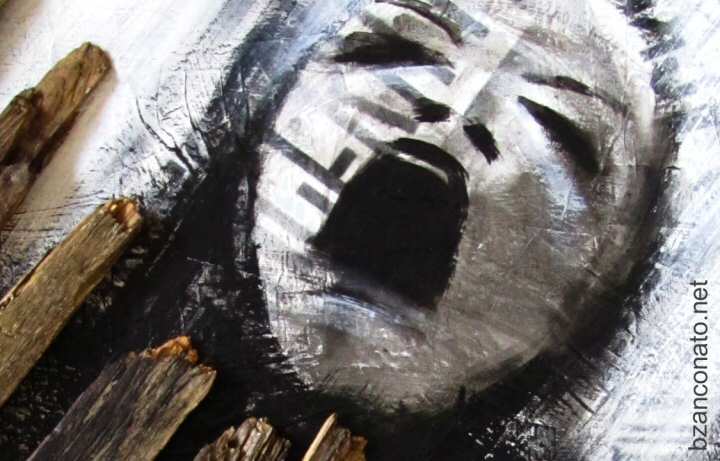
With “RUACH”, B.Zanconato plays with the various meanings of the term. On the purely visual plane, the figure, depicted over a barrier consisting of old woods, emerges to pull a long breath of fresh air (rùach). On that symbolic, she represents the spirit (rùach) that has long been locked up in the deepest depths of our being and which, as a result of the triggering of process of rediscovery, is finally released, emerging from the depths with a breath (again rùach).
And this is the fundamental element in the philosophical view of the artist: our spirit or soul, whatever you want, is, in the words of Henley, indomitable but requires that you free it. We must discover and retrieve our profound essence and build up our view of life that is not necessarily the same as the worldview that proposed to us by the society. Indeed, the contemporary world as mentioned is “chaos”, a sort of global supermarket, where everything coexists and follows the logic of supply and demand. Everything is for sale; everything has a monetary value only. Pity that we then realizes that this financial vision of life, in the short term, is insecure and unable to produce the answers we would like.
On the other hand, however, the human condition itself is characterized by precariousness. Poor vision of science has led us to think that we can dominate the events and nature, but obviously not so: the consequences of climate change are an easy example. In all cases these are illusions: “whether the man is opening the eyes or to pretend not to see .... still sees nothing and proceeds to groping on the dark path of life.”
And this is the theme of “EQUILIBRIO” (equilibrium, balance). B.Zanconato explains that the artwork is a representation of the human condition, that is, “a subtle balance between marvel and abyss: we can try strong joys but a moment later, without warning, drop in total darkness. Similarly, just when we're on the brink of a precipice, something or someone can extend a hand and change our perspective.
And this is the fundamental element in the philosophical view of the artist: our spirit or soul, whatever you want, is, in the words of Henley, indomitable but requires that you free it. We must discover and retrieve our profound essence and build up our view of life that is not necessarily the same as the worldview that proposed to us by the society. Indeed, the contemporary world as mentioned is “chaos”, a sort of global supermarket, where everything coexists and follows the logic of supply and demand. Everything is for sale; everything has a monetary value only. Pity that we then realizes that this financial vision of life, in the short term, is insecure and unable to produce the answers we would like.
On the other hand, however, the human condition itself is characterized by precariousness. Poor vision of science has led us to think that we can dominate the events and nature, but obviously not so: the consequences of climate change are an easy example. In all cases these are illusions: “whether the man is opening the eyes or to pretend not to see .... still sees nothing and proceeds to groping on the dark path of life.”
And this is the theme of “EQUILIBRIO” (equilibrium, balance). B.Zanconato explains that the artwork is a representation of the human condition, that is, “a subtle balance between marvel and abyss: we can try strong joys but a moment later, without warning, drop in total darkness. Similarly, just when we're on the brink of a precipice, something or someone can extend a hand and change our perspective.
When a person has become aware of this situation, in order to survive on the path of knowledge, can only take on the mood of the warrior who – as don Juan, the shaman master of Carlos Castaneda, sais - is to keep balance the terror of being a man with the wonder of being a man.” And it is precisely this sentence, which is found, in English, at the base of the work: “the terror of being a man with the wonder of being a man”.
If on the one hand, the true existence cannot disregard death, abyss, nothing, on the other hand it also represents our opportunity, unique and unrepeatable, to be played with our personal and true sense of life, leaving a mark of our passage.
If on the one hand, the true existence cannot disregard death, abyss, nothing, on the other hand it also represents our opportunity, unique and unrepeatable, to be played with our personal and true sense of life, leaving a mark of our passage.
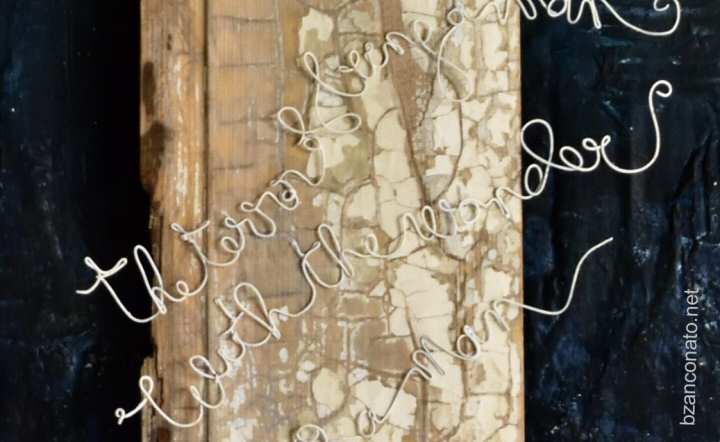
And that brings us to a next artwork on display: “DENKEN OHNE GELANDER”. “Denken ohne gelander”, to think without railings, in full freedom, is one of the messages that Hannah Arendt left us. The thought is a dialogue with ourselves and our reaction to things, situations, to the world.
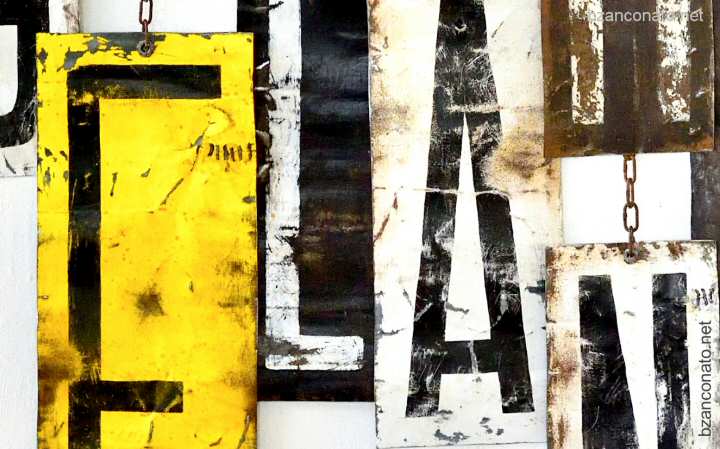
It is also a way to create a vision that then is the basis of the personal behaviour and which opposes the conformity, the massification and the passivity of the thinking, feelings and behaviours that often homologation determines. Think (Denken) is a way to assert our individuality, is the affirmation of the subjective against what, increasingly, is passed off as factual (if not scientific). It's going against the wind, also because not always thought find answers to questions that it asks.
If then the condition of man is an intrinsic insecurity which, however, becomes an opportunity to play at the very best when this situation is metabolised, personal thinking (denken) becomes the basic element to take advantage of it. To think without railings (denken ohne gelander), creatively, in full freedom, becomes the key to give meaning to a life that otherwise would not ours. This does not mean solving the evil of the world: but, starting from the consideration of the chaos, the inevitability of fate that awaits us, it means to discover and leverage the skills and talents of which we were endowed (and give meaning to our life). And it is this fundamental personal analysis, that everyone can lead, the key to free ourselves from the shackles of contemporaneity, which, in disguise, pushes for conformity, uniformity (and consequently the absence) of thought.
With her latest artwork, “DER SUCHENDE” , which also gives the title of the exhibition, B.Zanconato transmits an invitation: that of the search. Like that of Siddhartha, the protagonist of the novel by H. Hesse, that inspired this artwork (another devanture). “Der Suchende”, in German literally “one who seeks”, represents for the artist the spirit of human existence: exactly the search. The search can be conducted at different levels. For example, one of our true essence, the discovery and development of our talents and, therefore, the definition of our personal thought. At the same time, the search is opening, enrichment, discovery of new ideas and new things.
The artist herself, quoting some passages of the book by H. Hesse, reports on part of her devanture: “No one will ever arrive to the release through the doctrine! To nobody you will ever, with words, communicate what happened to you in the time of your enlightenment. The doctrine does not contain the secret ...
If then the condition of man is an intrinsic insecurity which, however, becomes an opportunity to play at the very best when this situation is metabolised, personal thinking (denken) becomes the basic element to take advantage of it. To think without railings (denken ohne gelander), creatively, in full freedom, becomes the key to give meaning to a life that otherwise would not ours. This does not mean solving the evil of the world: but, starting from the consideration of the chaos, the inevitability of fate that awaits us, it means to discover and leverage the skills and talents of which we were endowed (and give meaning to our life). And it is this fundamental personal analysis, that everyone can lead, the key to free ourselves from the shackles of contemporaneity, which, in disguise, pushes for conformity, uniformity (and consequently the absence) of thought.
With her latest artwork, “DER SUCHENDE” , which also gives the title of the exhibition, B.Zanconato transmits an invitation: that of the search. Like that of Siddhartha, the protagonist of the novel by H. Hesse, that inspired this artwork (another devanture). “Der Suchende”, in German literally “one who seeks”, represents for the artist the spirit of human existence: exactly the search. The search can be conducted at different levels. For example, one of our true essence, the discovery and development of our talents and, therefore, the definition of our personal thought. At the same time, the search is opening, enrichment, discovery of new ideas and new things.
The artist herself, quoting some passages of the book by H. Hesse, reports on part of her devanture: “No one will ever arrive to the release through the doctrine! To nobody you will ever, with words, communicate what happened to you in the time of your enlightenment. The doctrine does not contain the secret ...
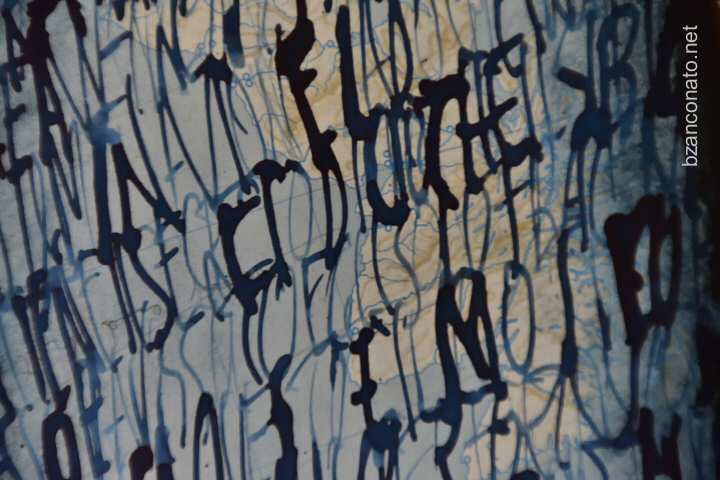
That is why I continue my journey: not to try another and better doctrine ... but to abandon all the doctrines and all the masters and achieve my goal by myself…”
"DER SUCHENDE" is therefore an explorer in search of himself and the world; as a warrior, he knows he has to move, at the same time, with caution and decision on the dangerous jungle of existence, conscious that every moment and every corner can hide his end. But that is precisely what makes life magical, unique and unrepeatable: and, for this reason, to play it at the very best.
"DER SUCHENDE" is therefore an explorer in search of himself and the world; as a warrior, he knows he has to move, at the same time, with caution and decision on the dangerous jungle of existence, conscious that every moment and every corner can hide his end. But that is precisely what makes life magical, unique and unrepeatable: and, for this reason, to play it at the very best.
